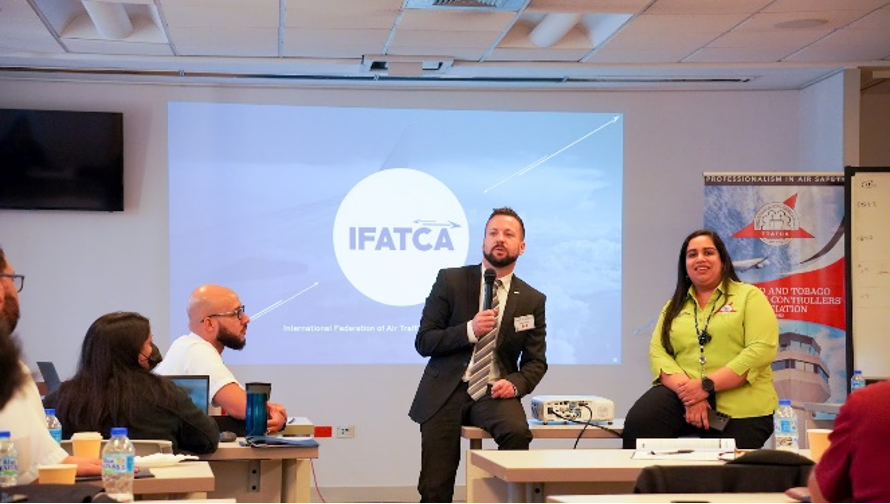The Trinidad and Tobago Air Traffic Controllers’ Association (TTATCA) will be hosting the 40th IFATCA Americas Regional Meeting between 15-17 October 2024 at the Hyatt Regency Port-of-Spain, Trinidad. This event will gather aviation professionals and stakeholders from North America, Central America, South America, and the Caribbean. The purpose of this event:
- To fulfil IFATCA’s objectives to protect & safeguard the interests of air traffic controllers and the profession
- To promote and uphold a high standard of knowledge and professionalism among air traffic controllers through the origination of policies and sharing of knowledge
- To create, maintain and enhance the worldwide fellowship of air traffic controllers
This meeting allows attendees to learn, share essential information and provide for a continuous exchange of ideas and experiences. It is an opportunity for Member Associations to be encouraged and to demonstrate their value by seeking to develop a collaborative and effective relationship with aviation authorities, air navigation services providers (ANSPs) and Industry Partners. This year’s meeting will be conducted in partnership with the Trinidad & Tobago Civil Aviation Authority (TTCAA).
ATTENDEES
Over 60 people are expected to travel to Trinidad for this Regional Meeting, which, with approximately 30 local ATCOs registered, is expected to have a historic high attendance.
Twenty-two nations will be represented: Argentina, Aruba, The Bahamas, Barbados, Canada, Chile, Curacao, Dominican Republic, Haiti, French Guiana, Guadeloupe, Grenada, Guyana, Jamaica, Mexico, Panama, Peru, St Lucia, Suriname, Trinidad & Tobago, The United States and Uruguay. Also, non-IFATCA members, such as French Guiana, Guadeloupe, and Suriname, will be in attendance.

MEETING AGENDA
The Meeting will include updates from IFATCA through its President and CEO Helena Sjöström Falk, EVP AMA Trish Gilbert and representatives of various IFATCA committees, task forces and programmes. Also on the agenda are an update from ICAO by Regional Officer- Josue Gonzalez, and presentations on “Occupational Health Impact on Air Traffic Controllers” and Critical Incident Stress Management (CISM) Program.

ABOUT TTATCA
The Trinidad and Tobago Air Traffic Controllers’ Association (TTATCA) is a non-profit, non-political professional association representing air traffic controllers, aeronautical information management officers, and communication navigation and surveillance technicians whose duties are responsible for the Piarco Flight Information Region (TTZP) through the Trinidad & Tobago Civil Aviation Authority (TTCAA). ; providing Area, Approach, Oceanic and Aerodrome control services. The Association is an affiliate member of IFATCA from May 1982, and mirrors IFATCA’s objectives.
TTATCA & IFATCA
Since becoming a member of IFATCA, the TTATCA has successfully hosted four Americas Regional Meetings, with the most recent being held in Tobago, 2010 as well as a hosting multiple IFATCA Standing Committees. In 1991, TTATCA hosted the IFATCA Annual Conference in Port-of-Spain. Two representatives of Trinidad & Tobago have served on the IFATCA executive since then:

Mr. Samuel Lamkin – President and Chief Executive Officer (1998-2002), Executive Vice President-Americas Region (1991-1997)

Mr. Alexis Brathwaite – President and Chief Executive Officer of IFATCA (2010-2014) and Deputy President (2007-2010)
ABOUT TRINIDAD & TOBAGO
Trinidad and Tobago is a twin-island nation located in the southeastern end of the Caribbean archipelago, near the coast of Venezuela. A former British colony, it gained it’s independence in 1962.
It is known for its diverse culture influenced by African, Indian, European and indigenous heritage. It is famous for its Carnival (the greatest show on earth), the steelpan (the national instrument of Trinidad & Tobago), Calypso (and soca) music, as well as its cultural dishes and cuisines.
The Spanish first colonised the island of Trinidad before it came under British control in the 1800s. Tobago, on the other hand, was colonised by the Spanish, British, Courlanders (modern-day Latvia), French, Americans and Dutch. After much fighting from European powers over the years after a treaty with the French it came back under British control in the 1800s where it would later be joined to Trinidad as one colony. A large number of African slaves were brought to the islands to work on plantations: cocoa, tobacco (mainly Tobago) and most notably sugarcane. Post-slavery, a large number of indentured servants (primarily from India) were brought to the islands.
During World War II, Trinidad and Tobago became the home of several US Military bases (Air Force and Naval) through the UK’s destroyers-for-bases deal. In 1962, the nation gained its independence from the UK and became a Republic in 1976. Today, the country is one of the most prosperous in the Caribbean, thanks largely to petroleum and natural gas processing.

THE TRINIDAD & TOBAGO CIVIL AVIATION AUTHORITY
The Trinidad & Tobago Civil Aviation Authority (TTCAA) is both the Regulator and Air Navigation Services Provider (ANSP) for the aforementioned nation. It was established by the Civil Aviation Act, 2001 (Act 11 of 2001). The principal function of the Authority is to regulate and administer a safe civil aviation system whilst ensuring that Trinidad and Tobago properly discharges its obligations under international civil aviation agreements and treaties.

THE PIARCO AIRSPACE
Trinidad & Tobago, through the TTCAA, is responsible for the Piarco FIR (TTZP) and provides Air Navigation Services throughout the Eastern Caribbean (from Antigua in the north to Trinidad in the south) and east of Barbados, stretching across the Atlantic Ocean toward Africa. It should be noted that each country is responsible for ANS within their own airspaces which resides from the surface to its TMA which varies between 13,500 -24,500 feet over each country.
The Piarco Flight Information shares borders with San Juan Oceanic FIR (Puerto Rico), Miquetia FIR (Venezuela), Georgetown FIR (Guyana), Paramaribo FIR (Suriname), Rochambeau FIR (French Guiana), Daka FIR (Senegal), Sal Oceanic (Cape Verde), Santa Maria FIR (Portugal), and New York Oceanic (USA), covering the entire Eastern Caribbean Region and a range of some 750,000 square miles.
Piarco (after which Trinidad’s International Airport and the Flight Information Region are named) is the Indigenous name of the first people of the island. It is named after the location on which the airport was built: the Piarco Savannah. The TTCAA Civil Aviation Complex is also located in this area.








